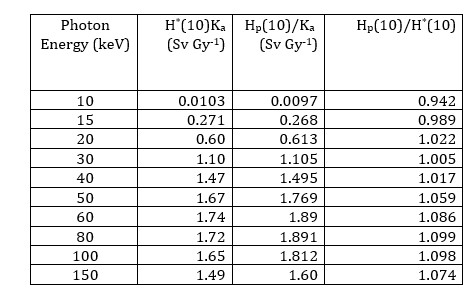Answer to Question #13624 Submitted to "Ask the Experts"
Category: Instrumentation and Measurements — Instrument Calibration (IC)
The following question was answered by an expert in the appropriate field:
If I am measuring ambient dose equivalent, H*(10), with a GM tube close to the operator x-ray machine, how do I calculate personal dose equivalent, Hp(10), for that place?
While I cannot provide an exact answer to your question, I will attempt to give you relevant information that should be helpful.
As relating to photon exposures, both ambient and personal dose equivalent are energy-dependent quantities. As you are likely aware, x-ray machines produce a spectrum of x-ray energies; we generally characterize beams in terms of effective energy, whose values depend on the machine voltage and the amount of filtration used in the machine. Diagnostic x-rays commonly exhibit effective energies on the order of 30% to 40% of the applied kilovoltage, but this can vary, depending on the particular application and possible variations in applied voltages and beam filtration. For the following comparisons between ambient dose equivalent and personal dose equivalent evaluated at the 10 mm depth—i.e., H*(10) and Hp(10)—I have taken values for the two quantities from Tables A.2 and A.4 of International Commission on Radiation Units and Measurements (ICRU) Report 47, Measurement of Dose Equivalents from External Photon and Electron Radiations. The values cited in the second and third columns below are actually ambient and personal dose equivalents per unit air kerma for monoenergetic photons so that you must exercise some judgment in applying them to specific x-ray beams. The last column below is the quotient of the respective column 3 values by the column 2 values and represents the ratio Hp(10)/H*(10).

For the listed energies (and for others) between 10 keV and 150 keV, we can conclude that the personal dose equivalent does not differ from the ambient dose equivalent by more than 10%. Thus, for many typical diagnostic procedures I would expect the ambient dose equivalent to be an acceptable proxy for the personal dose equivalent for leakage radiation and scattered x radiation to which personnel might be exposed.
I hope this is helpful to you.
George Chabot CHP, PhD


